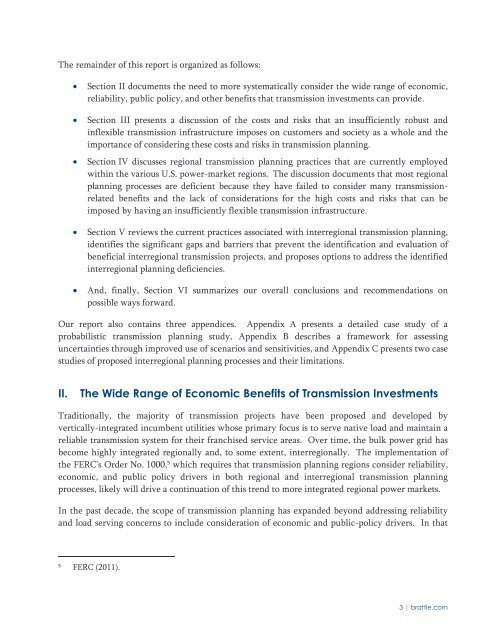THE BRATTLE GROUP
pvrbYG
pvrbYG
Create successful ePaper yourself
Turn your PDF publications into a flip-book with our unique Google optimized e-Paper software.
The remainder of this report is organized as follows:<br />
<br />
<br />
<br />
<br />
<br />
Section II documents the need to more systematically consider the wide range of economic,<br />
reliability, public policy, and other benefits that transmission investments can provide.<br />
Section III presents a discussion of the costs and risks that an insufficiently robust and<br />
inflexible transmission infrastructure imposes on customers and society as a whole and the<br />
importance of considering these costs and risks in transmission planning.<br />
Section IV discusses regional transmission planning practices that are currently employed<br />
within the various U.S. power-market regions. The discussion documents that most regional<br />
planning processes are deficient because they have failed to consider many transmissionrelated<br />
benefits and the lack of considerations for the high costs and risks that can be<br />
imposed by having an insufficiently flexible transmission infrastructure.<br />
Section V reviews the current practices associated with interregional transmission planning,<br />
identifies the significant gaps and barriers that prevent the identification and evaluation of<br />
beneficial interregional transmission projects, and proposes options to address the identified<br />
interregional planning deficiencies.<br />
And, finally, Section VI summarizes our overall conclusions and recommendations on<br />
possible ways forward.<br />
Our report also contains three appendices. Appendix A presents a detailed case study of a<br />
probabilistic transmission planning study, Appendix B describes a framework for assessing<br />
uncertainties through improved use of scenarios and sensitivities, and Appendix C presents two case<br />
studies of proposed interregional planning processes and their limitations.<br />
II.<br />
The Wide Range of Economic Benefits of Transmission Investments<br />
Traditionally, the majority of transmission projects have been proposed and developed by<br />
vertically-integrated incumbent utilities whose primary focus is to serve native load and maintain a<br />
reliable transmission system for their franchised service areas. Over time, the bulk power grid has<br />
become highly integrated regionally and, to some extent, interregionally. The implementation of<br />
the FERC’s Order No. 1000, 5 which requires that transmission planning regions consider reliability,<br />
economic, and public policy drivers in both regional and interregional transmission planning<br />
processes, likely will drive a continuation of this trend to more integrated regional power markets.<br />
In the past decade, the scope of transmission planning has expanded beyond addressing reliability<br />
and load serving concerns to include consideration of economic and public-policy drivers. In that<br />
5<br />
FERC (2011).<br />
3 | brattle.com


